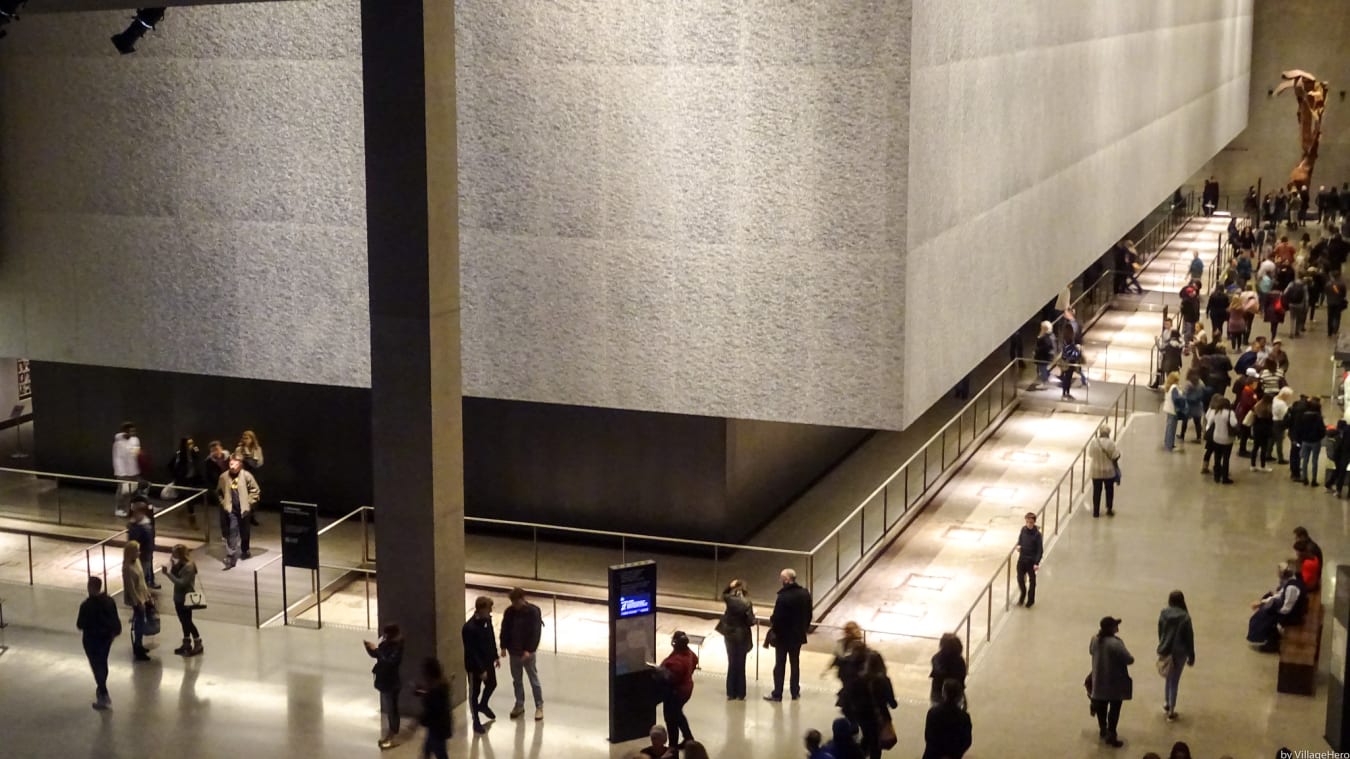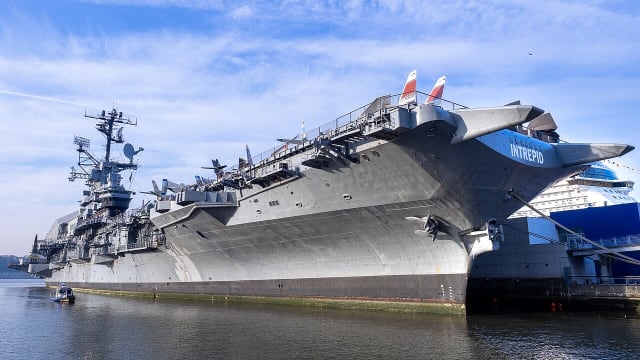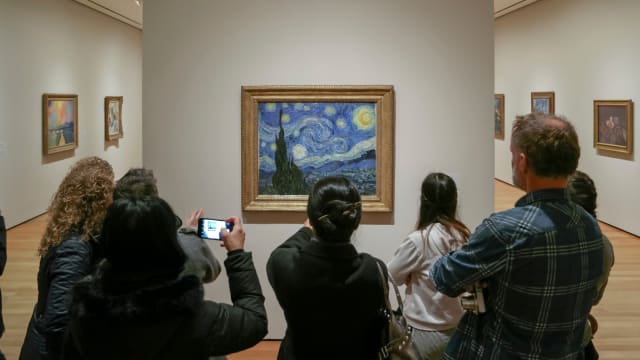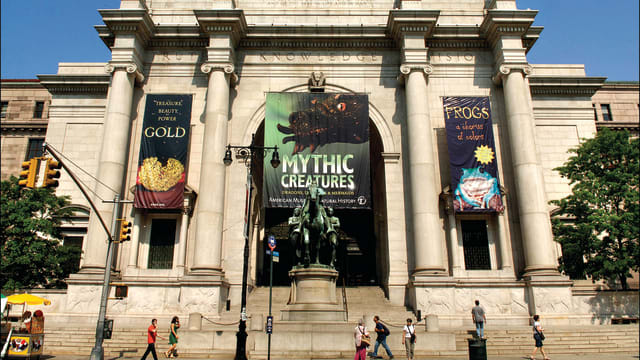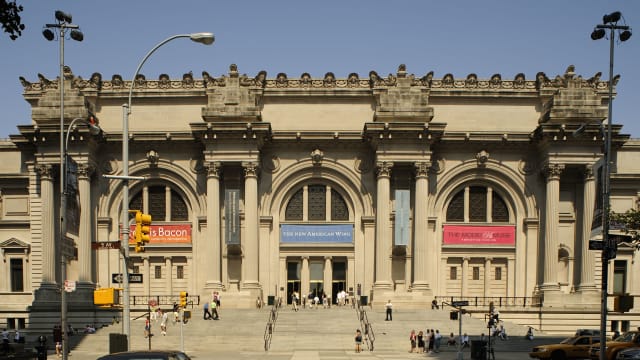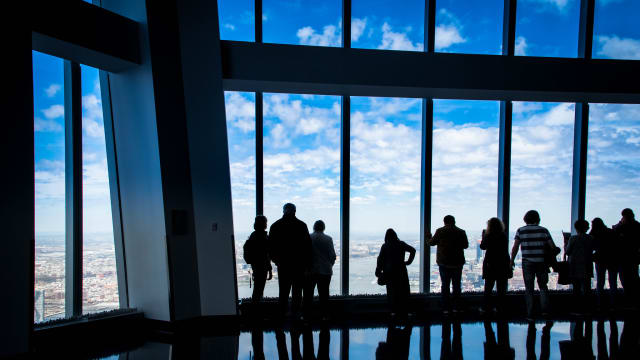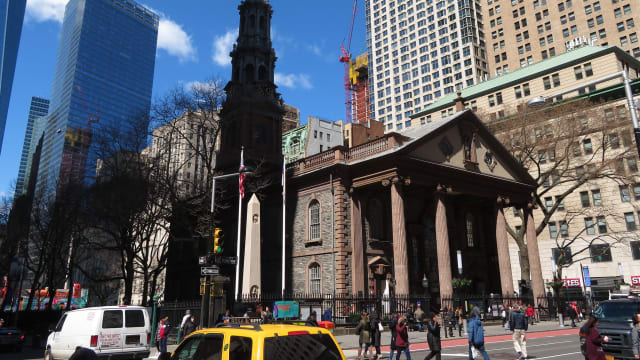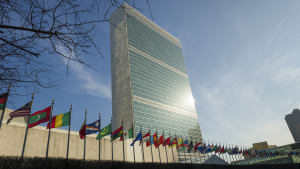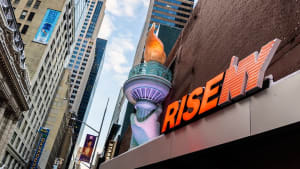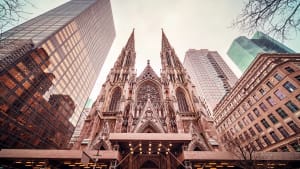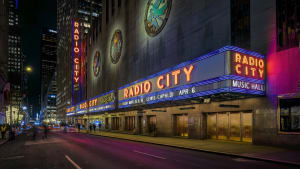The National 9/11 Museum
When you visit the National September 11 Museum, you step into a space that captures the somber yet remarkable spirit of resilience that defines New York. Located at the historic site of the World Trade Center, this underground museum isn't just about tragedy; it's a tribute to strength, courage, and the unyielding human spirit.
The 9/11 Museum in a nutshell
The National September 11 Museum is an essential destination for understanding the impactful history and enduring spirit of New York City following the events of September 11, 2001.
Location: 180 Greenwich Street, at the heart of the 9/11 Memorial site.
Transportation: Accessible via multiple subway lines including the E line to World Trade Center and the 1 line to WTC/Cortlandt. Bus routes and nearby parking options like the Battery Parking Garage provide additional access.
Tickets: It is advisable to purchase tickets online in advance to select preferred admission times and avoid queues. Discount passes such as the New York Pass and CityPASS offer entry as part of their packages.
Opening Times: Open Wednesday to Monday from 9:00 AM to 7:00 PM, with last entry at 5:30 PM. Closed on Tuesdays and on September 11th to the general public.
Nestled within the sacred grounds of the World Trade Center site, this museum serves not only as a guardian of memories from the fateful day of September 11, 2001, but also as a testament to human resilience. As you descend into the museum’s depths, you are greeted by the hauntingly poignant sight of the Twin Towers’ original pillars, standing as silent witnesses to history.
The museum’s exhibitions are carefully segmented into three primary areas, each offering a unique perspective on the events and aftermath of that day. The historical exhibition delves into the detailed chronology of the events, providing insights into not only what happened on September 11 but also the global impact and the ensuing actions at the Pentagon and with Flight 93. Meanwhile, the “In Memoriam” exhibition serves as a heartfelt tribute to the lives lost, both in the 2001 attacks and the bombing in 1993, offering a personal glimpse into the stories of the victims and the void they left behind.
As you explore, you’ll feel the weight of the city’s darkest day, coupled with an inspiring reminder of its capacity to rebuild and renew. Remember, as you walk through this memorial, you’re not just revisiting a site of tragedy; you’re witnessing the indomitable spirit of New York and the global community it touched.
Practical Information
Planning your visit to the National September 11 Museum requires some preparation to ensure a smooth and reflective experience. The museum is easily accessible yet nested in a bustling part of the city, which merits some navigation tips.
Location
The National September 11 Museum is located at 180 Greenwich Street, at the World Trade Center site in Lower Manhattan, New York City.
How to get there
Finding your way to the museum is straightforward, given its prominence and central location. The museum itself is part of the larger 9/11 Memorial site, making it a focal point for visitors and locals alike.
Subway
The most convenient way to reach the museum is by subway. The closest stations are the E line at the World Trade Center and the 1 line at the WTC/Cortlandt station, which will place you right at the museum’s doorstep.
Alternatively, the Fulton Street station serves multiple lines (A, C, J, Z, 2, 3, 4, 5), offering flexibility depending on your starting point. This station is just a short walk from the museum, surrounded by various amenities.
Bus
Several bus routes also serve the museum area well. For instance, the M55 Southbound stops at Broadway and Thames Street, while the M20 Southbound stops on South End Avenue, both within walking distance to the museum. These buses provide a convenient option if you’re touring other parts of the city as well.
Hop-on Hop-off Buses
Opting for a hop-on hop-off bus tour can be an excellent choice, especially if you’re looking to explore a broader swath of the city. There’s a stop near the museum, though it does require a bit of walking.
These buses offer the flexibility of exploring at your own pace, with the added benefit of seeing many major attractions along the way.
Driving
While driving in New York City can be challenging due to traffic and limited parking, if you choose to drive, consider parking at the Battery Parking Garage on 70 Greenwich Street. It’s the most convenient option, though public transportation is generally more advisable.
Tickets
To enhance your experience and minimize wait times, purchasing your tickets online is highly recommended. You can select your preferred date and time for visiting the museum, which helps in planning your day more efficiently.
Upon purchase, you’ll receive a digital voucher that can be shown on your phone, making it both convenient and eco-friendly.
Entrance with Discount Passes
For those looking to explore more of what New York has to offer, consider the Go New York Explorer Pass or the New York Pass. These passes include entry to the 9/11 Museum along with many other attractions, providing a cost-effective way to enjoy the city.
The New York CityPASS is another great option, especially for first-time visitors, offering significant savings and entry to multiple top sites.
GoCity Explorer Pass
The Go New York Explorer Pass lets you choose from over 90 top attractions. It’s a flexible and economical way to explore, ensuring you get the most out of your visit to the city.
The New York Pass
For those looking to dive deep into New York’s vibrant cultural scene, the New York Pass offers access to over 100 attractions. Whether it’s museums, tours, or bike rentals, this pass has you covered.
New York CityPASS
First-time visitors will find the New York CityPASS invaluable. It grants entry to five top attractions, including the 9/11 Museum, and saves up to 40% on normal rates, valid for 9 consecutive days.
Opening Times
The museum operates from Wednesday to Monday from 9:00 am to 7:00 pm, with the last entry at 5:30 pm. It remains closed on Tuesdays and to the general public on September 11th.
Best time to visit
To avoid crowds and fully absorb the museum’s offerings, visiting early in the morning or later in the evening is advisable. This timing allows you to explore the exhibits with fewer interruptions and a more personal space, ensuring a more impactful experience.
Guided Tours and Experiences
Explore the profound legacy of September 11, with a selection of guided tours that offer an in-depth look at the events and the resilience that followed. These tours provide a mix of solemn remembrance and educational insights, with options to visit significant landmarks associated with that day.
9/11 Memorial & Ground Zero Tour with Optional Museum Entry
This walking tour offers a poignant journey through the Ground Zero site and the National 9/11 Memorial. Led by a certified guide with personal ties to the events of 9/11, you’ll hear moving stories of tragedy and heroism. The tour offers an opportunity to deeply connect with the stories behind the sites. For a more comprehensive experience, you can choose to include a ticket to the National 9/11 Museum.
All-Access 9/11 Experience: Ground Zero Tour, Memorial, Museum, and One World Observatory
Embark on a comprehensive guided tour of Ground Zero and the 9/11 Memorial, gaining insights into the profound impact of September 11, 2001. This all-access pass not only includes skip-the-line entry to the 9/11 Museum and Memorial but also grants admission to the One World Observatory, where you can enjoy panoramic views of New York City.
Statue of Liberty, Ellis Island & 9/11 Memorial Guided Tour
Maximize your experience in New York City with a tour that encompasses three iconic locations: the Statue of Liberty, Ellis Island, and the 9/11 Memorial. Starting with a ferry ride to the Statue of Liberty, you’ll then explore Ellis Island to learn about the immigrant journey to America.
The tour concludes at the 9/11 Memorial in Lower Manhattan with a visit to the 9/11 Museum, making for a full day of historical exploration and reflection, with all entry fees and ferry rides included for a hassle-free experience.
Is Ground Zero And The 9/11 Memorial The Same Thing?
The National September 11 Museum is part of the larger National September 11 Memorial, located at Ground Zero, the area formerly occupied by the World Trade Center in Lower Manhattan, New York City. Ground Zero is the name given to the site after the tragic events of September 11, 2001.
The memorial itself, which includes the museum, is dedicated to honoring the memories of those who lost their lives in the attacks at the World Trade Center, near Shanksville, PA, and at the Pentagon, along with the six individuals who died in the 1993 bombing at the World Trade Center.
The memorial features twin reflecting pools set in the footprints of the former North and South Towers, bordered by bronze panels with the names of every person who perished in the 2001 and 1993 attacks. The area is freely accessible to the public and includes the Survivor Tree, a Callery pear tree that survived the devastation and symbolizes resilience and renewal. Visitors can reflect and pay respects in this solemn space, amidst the greenery and tranquility of the memorial park.
It’s only necessary to purchase a ticket to visit the museum, which is primarily located underground.
What to Expect at the 9/11 Museum
As you approach the 9/11 Museum, the first elements to greet you are the twin memorial pools, known as “Reflecting Absence.” These pools, designed by architect Michael Arad, are set in the footprints of the original towers. The continuous cascade of water creates a tranquil atmosphere, with the pools designed so that the center seems infinitely deep, representing the profound loss felt by many.
The museum entrance is located between these pools and leads into the expansive underground museum space. Here, surrounded by the newly constructed skyscrapers of the World Trade Center, including the towering Freedom Tower, visitors can start or end their journey with breathtaking views from the One World Observatory. Throughout the museum and memorial, other significant artifacts like the Survivor Tree, The Sphere, and the FDNY Memorial Wall provide poignant reminders of the day and its aftermath.
Survivors’ Stairs
Upon entering the museum, visitors are immediately confronted with the tridents—two large steel remnants from the original World Trade Center—that set the tone for the visit. The journey continues past the Memorial Hall down to the basement, 21 meters below ground, where the Survivor Stairs are located. These stairs, which many used to escape the towers, symbolize the desperate fight for survival on that day. The museum not only honors nearly 3,000 lives lost but also emphasizes the global impact of the attacks and the triumph of human dignity over tragedy.
Exhibitions in the 9/11 Museum
The 9/11 Museum hosts two main exhibitions. The Historical Exhibition takes visitors through a chronological journey of the day, from the morning of September 11, 2001, to its devastating end. This exhibition uses artifacts, photos, and personal stories to convey the sequence of events and their impact.
The Memorial Exhibition, meanwhile, offers a more personal touch, featuring the “Wall of Faces,” where visitors can see photos of the victims and learn about their lives through information provided by their families, creating a deeply moving tribute to those who perished.
Tips to Visit the 9/11 Museum
Visiting the 9/11 Museum is an emotionally profound experience, and planning your visit can help you make the most of your time:
- Prepare for Security: Expect airport-like security measures. Prohibited items include alcohol, glass bottles, and large bags.
- Use the Audio Guide: Enhance your visit with an audio guide, available via an app or at the information desk.
- Time Your Visit: Allocate 1.5 to 2 hours to explore, more if you plan to watch the films.
- Plan for Quiet Time: After your visit, consider a quiet lunch or a walk in a nearby park to reflect on your experience.
- Book Guided Tours in Advance: For a deeper understanding, book a guided tour. These tours offer insights into each artifact and its significance, but tickets are limited.
- Consider Visiting without Young Children: The museum can be an intense experience, and you may prefer to visit without very young family members.
Accessibility
The 9/11 Museum and Memorial are committed to accessibility for all visitors. The entrance and all exhibits are wheelchair accessible, and personal mobility devices are welcome. Free manual wheelchairs and walkers are available on a first-come, first-served basis at the coat check. All public restrooms are equipped with accessible stalls, and service animals are allowed on the premises.
For those who need a quiet space during their visit, the Reflecting on 9/11 Studio offers a tranquil retreat. If additional assistance is needed, visitors can contact the Access Department or ask a staff member for guidance.
Frequently Asked Questions
-
Ground Zero refers to the site of the World Trade Center after its destruction.
-
Yes, the National September 11 Memorial is free and open to the public.
-
Names can be located using kiosks near the reflecting pools.
-
The Survivor Tree is a pear tree that survived the attacks. The Sphere is a sculpture that was found in the rubble.
-
Yes, guided tours are available and can be booked in advance.
-
The museum is open Wednesday to Monday from 9:00 AM to 7:00 PM.
-
Large bags and backpacks are not allowed.
-
Photography is allowed, but visitors are asked to be respectful.
-
At the 9/11 museum, wheelchairs are available for free at the coat check on a first-come, first-served basis.
-
Yes, service animals are welcome at the museum and memorial.
-
Early morning or late evening visits are recommended.
-
A typical visit lasts between 1.5 to 2 hours, longer if watching films.
-
There are no food services inside the museum, but nearby areas offer options.
-
The Reflecting on 9/11 Studio serves as a quiet space for visitors.
-
The pools represent the footprints of the original towers and symbolize the ongoing impact of loss.
Where to Stay Near the 9/11 Museum
Staying near the 9/11 Museum can be a convenient option for those wishing to explore Lower Manhattan. The area is not only rich in history but also offers easy access to other major attractions and excellent transportation links. Hotels in this area cater to a range of budgets and preferences, making it a practical choice for both leisure and business travelers.
For those seeking a quieter experience or perhaps more budget-friendly options, consider staying in areas like Midtown, which is still conveniently accessible by subway but offers a different pace and atmosphere. Midtown offers a variety of cultural and entertainment options, ensuring that your stay in New York City is as dynamic and varied as the city itself.
Other Interesting Museums in New York City
New York City is a hub for cultural and historical exploration, with a plethora of museums to visit beyond the 9/11 Memorial and Museum. Here’s a guide to some other notable museums that you should consider adding to your itinerary:
Intrepid Sea, Air, and Space Museum
Explore the legendary aircraft carrier Intrepid, the space shuttle Enterprise, and a variety of aircraft and submarines.
This museum provides a fascinating look at American military and aerospace technology.
View details
Explore the legendary aircraft carrier Intrepid, the space shuttle Enterprise, and a variety of aircraft and submarines.
This museum provides a fascinating look at American military and aerospace technology.
The Museum of Modern Art (MoMA)
MoMA houses an extensive collection of modern and contemporary art, from innovative European paintings and sculptures of the 1880s to today’s film, design, and performance art.
View details
MoMA houses an extensive collection of modern and contemporary art, from innovative European paintings and sculptures of the 1880s to today’s film, design, and performance art.
The American Museum of Natural History
One of the largest museums in the world, it offers exhibits ranging from dinosaur fossils to outer space and everything in-between.
View details
One of the largest museums in the world, it offers exhibits ranging from dinosaur fossils to outer space and everything in-between.
Metropolitan Museum of Art (The Met)
The Met presents over 5,000 years of art from around the world for everyone to experience and enjoy.
View details
The Met presents over 5,000 years of art from around the world for everyone to experience and enjoy.
New York Transit Museum
Located in a historic 1936 subway station in Brooklyn, this museum offers a glimpse into the evolution of New York City’s public transport system.
Located in a historic 1936 subway station in Brooklyn, this museum offers a glimpse into the evolution of New York City’s public transport system.
Other Nearby Attractions
The National September 11 Museum is ideally situated in Lower Manhattan, a prime location that serves as a gateway to numerous other fascinating attractions. This area, rich in history and modern development, offers visitors a unique blend of sights ranging from poignant historical landmarks to stunning architectural feats. Whether you’re looking to reflect on the past or enjoy contemporary marvels, this part of New York City provides a seamless continuation of exploration and discovery.
From scenic parks and iconic buildings to cultural centers, the area surrounding the 9/11 Museum is brimming with attractions that cater to all interests. After paying your respects at the museum, you can easily spend the rest of the day wandering through nearby locations, each offering its own unique slice of New York City’s vibrant tapestry. These attractions not only enhance your understanding of the city’s past and present but also make for a fulfilling and varied travel itinerary.
One World Observatory
Perched atop the Freedom Tower, the One World Observatory offers breathtaking 360-degree views of New York City. This observation deck allows you to see the city from above and learn about its history through immersive exhibitions.
A visit here complements a day spent at the 9/11 Museum by providing a literal high point to reflect on the city’s resilience and renewal.
View details
Perched atop the Freedom Tower, the One World Observatory offers breathtaking 360-degree views of New York City. This observation deck allows you to see the city from above and learn about its history through immersive exhibitions.
A visit here complements a day spent at the 9/11 Museum by providing a literal high point to reflect on the city’s resilience and renewal.
The Oculus
The Oculus, designed by architect Santiago Calatrava, serves as a stunning example of modern architecture and a hub of transportation.
Inside, visitors will find a sprawling plaza filled with shops and seasonal events, making it a vibrant spot for those looking to experience New York City’s dynamic energy.
The Oculus, designed by architect Santiago Calatrava, serves as a stunning example of modern architecture and a hub of transportation.
Inside, visitors will find a sprawling plaza filled with shops and seasonal events, making it a vibrant spot for those looking to experience New York City’s dynamic energy.
Battery Park
Located at the southern tip of Manhattan, Battery Park offers serene views of the Statue of Liberty and Ellis Island.
It’s a perfect place for a peaceful walk or a ferry ride to the islands, providing a green oasis amidst the urban environment.
Located at the southern tip of Manhattan, Battery Park offers serene views of the Statue of Liberty and Ellis Island.
It’s a perfect place for a peaceful walk or a ferry ride to the islands, providing a green oasis amidst the urban environment.
Wall Street
Walk along Wall Street, the financial heart of the world, and explore landmarks like the New York Stock Exchange and the Charging Bull statue.
This area offers a glimpse into the bustling world of finance and its significant role in global economics.
Walk along Wall Street, the financial heart of the world, and explore landmarks like the New York Stock Exchange and the Charging Bull statue.
This area offers a glimpse into the bustling world of finance and its significant role in global economics.
Trinity Church
Trinity Church is not only a place of worship but also a historical treasure dating back to 1698, featuring a striking Gothic Revival architecture and a peaceful churchyard where one can find the graves of notable historical figures.
Trinity Church is not only a place of worship but also a historical treasure dating back to 1698, featuring a striking Gothic Revival architecture and a peaceful churchyard where one can find the graves of notable historical figures.
St. Paul’s Chapel
Located directly across from the World Trade Center site, St. Paul’s Chapel survived the 9/11 attacks without damage and served as a sanctuary for recovery workers.
Its history and resilience make it a poignant stop for those exploring the area’s history.
View details
Located directly across from the World Trade Center site, St. Paul’s Chapel survived the 9/11 attacks without damage and served as a sanctuary for recovery workers.
Its history and resilience make it a poignant stop for those exploring the area’s history.
Brookfield Place
This upscale shopping center and office complex near the Hudson River is known for its luxury shops, dining options, and vibrant public spaces that host a variety of cultural events, making it a lively destination for entertainment and leisure.
This upscale shopping center and office complex near the Hudson River is known for its luxury shops, dining options, and vibrant public spaces that host a variety of cultural events, making it a lively destination for entertainment and leisure.
